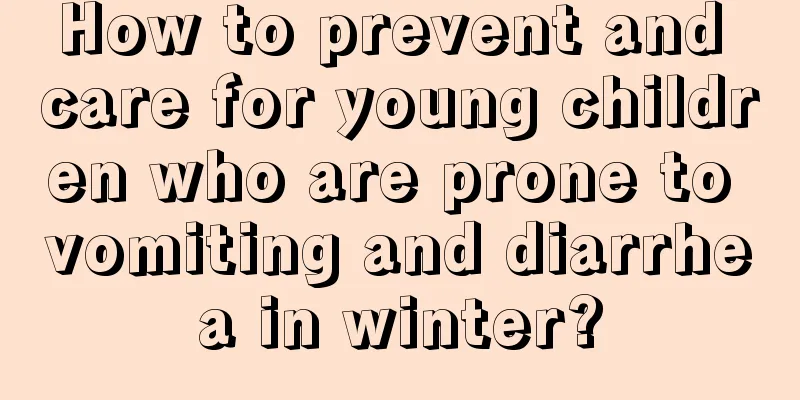Emergency plan and method for newborn choking

|
The birth of every new life will make our parents very happy, but the recent phenomenon of newborns choking on milk has made many parents worried. We all know that there are many cases of one-month-old babies spitting up milk around us. This disease has a great impact on us. Many people have sought medical treatment everywhere, but have not received good treatment. Not only has it taken up a lot of time and energy, but it has also had a great impact on the normal work and life of the children and their parents. Many people are eager to find a timely and effective treatment method. So what is a good way to treat this disease? Let us now learn about the emergency plan for newborn choking on milk. Treatment: 1. It is recommended to hold the baby while breastfeeding. If breastfeeding in a lying position is necessary, the head should be high and the feet should be low. For breastfeeding, clean the nipples with warm water before each feeding, and hold up the breast with four fingers, with the thumb placed on the areola on the nipple to slow down the flow of milk. For bottle-feeding, clean the feeding utensils with boiling water before each feeding, and feed after the nipples are filled with milk. The nipple hole should not be too large. After breastfeeding, hold the newborn upright and pat its back to help it expel the swallowed air. It is not advisable to lift the newborn's lower limbs to change diapers within a short period of time after breastfeeding. 2. For infants and young children who vomit frequently, if organic diseases and gastrointestinal inflammation are ruled out, most of the cases are gastroesophageal reflux. You can choose the lateral position with the head high and feet low, with the head raised 15°; for children with gastroesophageal reflux, the head can be placed in the prone position, for 20 minutes each time, 2-4 times a day. However, there must be someone to take care of the patient during the prone position to prevent respiratory apnea. This can reduce the frequency of reflux, reduce the number of vomiting, prevent aspiration of vomitus, and avoid aspiration pneumonia and suffocation. 3. Recurrent vomiting and nervous vomiting: Strengthen physical exercise, improve physical fitness, lead a regular life, avoid overeating, try to keep your body and mind calm, and don't force yourself to eat. Also, be sure not to add any stress to the child, as this will make the vomiting worse. Children with the disease should arrange their lives reasonably, including diet, strengthen physical exercise and increase physiological sleep time. People around the child should not pay too much attention to the child's vomiting symptoms and should avoid showing nervousness and worry in front of the child to increase his confidence in treatment. At the same time, keep the environment clean, deal with the child's vomit in a timely manner, and replace contaminated clothes, sheets, and quilts in a timely manner to avoid further irritation to the child. When vomiting, you should stay by the child's side and give him/her mental comfort; after vomiting, help him/her rinse his/her mouth in time, bathe the child frequently, and remove the odor left on the body by vomiting. 4. For children who are prone to vomiting, especially those who vomit after catching a cold or coughing: they should strengthen their nutrition and physical exercise to improve their body's immunity, or take bovine colostrum and transfer factor to prevent colds; meals should be regular and quantitative; do not eat too much; food must be fresh and hygienic; do not feed the child overly spicy, smoked, or greasy food. 5. Children who are prone to vomiting when taking medicine: when feeding the medicine, the liquid medicine should not be too hot or too cold; children who are difficult to feed medicine can also be given small amounts and multiple doses; if necessary, they can take a mouthful and wait for a while before taking the medicine again. After vomiting, clean the mouth, face, and neck skin promptly, and change contaminated clothes and bed sheets. 6. Some children are born with a sensitive pharyngeal reflex, which can easily cause vomiting. They are prone to vomiting when they catch a cold, so you should tell your doctor when you see him/her that you should eat easily digestible liquid or semi-liquid food at this time. Don't eat too much, usually about half of your usual diet. The above content introduces us to the emergency plan for newborn choking on milk. By understanding the above content, we can understand the treatment method. We can tell the above methods to everyone around us so that all patients can recover their health as soon as possible and let the babies grow up healthily and happily. At the same time, it can also relieve our parents' anxiety and benefit the whole family. |
<<: What are the recipes for babies over six months old?
>>: Treatment for neonatal insecurity
Recommend
Treatment of cough and fever in 3-year-old baby
Many of us are particularly susceptible to catchi...
What department should I go to for children with language disorders?
There are many reasons why children have language...
What causes dark skin in children?
What is the reason for children’s dark skin? Chil...
What to do if your child wets the bed at night
Bedwetting is clinically known as enuresis, and m...
Why does a two-year-old baby sneeze and have a runny nose?
If a two-year-old baby sneezes and has a runny no...
Signs and symptoms of calcium deficiency in babies, mothers, please pay attention!
The baby's body is relatively fragile. When a...
Treatment of urticaria in children
Children are the bond that holds a family togethe...
Newborn heel blood screening method
Newborn heel blood screening is a method of check...
What are the reasons why full-month babies don’t like to sleep?
It is normal for babies to wake up many times dur...
At what months can babies turn sideways?
As the baby grows up day by day, his every move w...
Taboos of leukoplakia at six years old
Children need to get the diphtheria and pertussis...
What to do if your child has a cough and stuffy nose
Coughing and nasal congestion in children is a co...
Why does the baby suddenly wake up while sleeping?
When babies are sleeping, they may suddenly wake ...
Why is the baby's stool dark green?
Nowadays, every child is the treasure of the fami...
Can a child take a bath when he has a fever?
Fever is the most common epidemic disease in norm...









